Residencehotels Group - Our history
Lorenzo Conci, CEO Residencehotels S.p.a.
Residencehotels is a family-run business. And not just because it’s always been owned by members of the same household. We can call ourselves a big family in a broader sense.
Many of our partners have been working with us for more than 20, 25 or even 30 years. Some of them started their careers at our properties and have never left since.
After the Second World War, brothers Fabio (born in 1920) and Alessandro (b. 1909) Conci, both engineers, set up a building business. Fabio, who had graduated at Bologna University, had been declared unfit to serve in the army as he suffered from phlebitis.
After getting a degree at Milan Polytechnic University in 1932, Alessandro became a second lieutenant and fought on the African front. Taken prisoner by the British, he went back to Trento at the end of 1946. Together with Fabio, who was already working in the building industry, he established a company called Alessandro e Fabio Conci Costruzioni.
Trento needed and wanted to bounce back: bombings had razed most of the town centre to the ground and there were plenty of job opportunities.
The 1950s in Italy are identified with the reconstruction of the country. Houses, businesses, but most importantly infrastructures, such as bridges, roads, hydroelectric power plants, and so on. In its heyday, the Conci brothers’ company gave work to as much as 500 people, with an established workforce of about 300.
In the next decade, a period of economic recovery (the so-called ‘Italian miracle’) prompted a considerable portion of the population to move from the countryside to the cities, where a thriving industrial activity was gaining momentum.
More and more citizens could afford cars and home ownership. Urban agglomerations began to sprawl, losing their centuries-old appearances. Beyond their traditional boundaries, suburbs popped up. The country was witnessing a true housing boom.
Besides Trento, the CONCI company started to consider possible projects in mountain areas, where a growing holiday craze encouraged families to build second homes. As a skiing enthusiast himself, Fabio pioneered this trend.
His passion for the mountains, his summer trips to the Brenta range and the first climbs originated in the 1930s, thanks to his older brother Alessandro, even though 11 years is quite a considerable gap at that age. By 1935-36, Alessandro had already met the strongest climbers of his time, including brothers Bruno and Catullo Detassis from Trento and Ettore Castiglioni, with whom he would climb several new routes opened by Ettore himself in the Brenta range. Unlike most of his peers, Alessandro was a young man of independent means and could afford to pay for his hobbies. Famously, Alessandro wrote a letter to Fabio from Sicily, where he was working as an engineer for SCAC, an Italian company specialising in reinforced concrete: “I’m glad to hear that our parents gave you the permission to spend the summer in the Brenta Dolomites. However, I’m afraid their permission is not enough. That’s why I’m attaching some money…”.
Thus, thanks to Alessandro, Fabio could join other young people from Trento who loved the surrounding mountains and learned to ski during the winter. He was literally in awe before those peaks and there was a specific spot, at the foot of the Sella range in Val Gardena, where Fabio told me he made a promise to himself: the decisions he would take from then on regarding his private life and his job would be made so that he could stay in the area and forever enjoy those magnificent sceneries.
The friends he spent time with shared his same passion for sports and especially professional skiing, with a particular veneration for champions such as Zeno Colò – the grouchy Tuscan who was friend with Giro d’Italia and Tour de France winner Fausto Coppi – and Toni Sailer, the legendary youngster from Kitzbühel who would win three races out of three during the 1956 Winter Olympics in Cortina d’Ampezzo.
While he was becoming familiar with this environment, Fabio also showed organising talents which came very handy in his entrepreneurial journey. By the end of the 1940s, he’d already been elected as president of the Trentino regional branch of the Italian Winter Sports Federation (FISI). He would later be national Vice president for 12 years, then FISI President from 1964 to 1970.
In this role, he helped young Val Gardena promoters to secure the 1970 Alpine Ski World Cup. He managed to get the deal done at the International Ski Federation convention in Beirut through an extensive network of alliances he’d been establishing while he was President of FISI and member of the FIS board.
The Conci brothers erected their first three buildings in the mountains in Madonna di Campiglio, not far from the Spinale cable car. The central building was a hotel, that they rented out. The first apartments were sold in 1963 under the slogan “Buy an apartment at our Residencehotel to spend your holidays at home…”. The flats were decorated by architect Joe Colombo, a successful designer. Fabio took inspiration from the houses he saw in the French Alps during his several visits to follow Alpine ski races.
Between 1963 and 1969, he built two more complexes (called Nardis and Mandron) in Madonna di Campiglio, as well as a block of flats in San Martino di Castrozza, one in Bellamonte a third in Selva di Val Gardena.
In June 1970, Fabio resigned as President of FISI mid-term, disheartened by the harsh criticism he was exposed to. In spite of a huge organisational success, the World Cup in Val Gardena had seen no medals for Italy, which triggered a bit of a hatchet job on him. Had he been patient enough, he would have reaped the benefits of his hard work at FISI in Milan: from 1971 to 1976, Gustavo Thoeni and Piero Gros won 5 World Cups in a raw, as well as World Championships and Olympic Games.
After the economic boom, the end of the 1960s was a time of inflation and political instability in Italy. My father realised that his construction initiatives in the mountains couldn’t be replicated and that it would be wiser to keep ownership of the properties and manage them for tourism purposes.
In 1971, the first germ of the Residencehotels Group as we know it today was born. My uncle Alessandro, still very attached to the building business, decided not to follow his brother in this new venture. During the early 1970s, Fabio gradually paid off Alessandro and gave the Group a new business name.
The first aparthotels were blocks of flats converted into holiday properties, with apartments being rented out for a minimum of one or two weeks. The workforce at the Trento headquarters consisted of a very capable office manager, my father’s long-standing secretary and 2 or 3 telephone operators.
By watching their idols win competition after competition, the Italians became familiar with and developed a passion for winter sports. But, more importantly, they wanted to learn to ski and go on skiing holidays. The trend kept growing, until the Sassongher and Contrin aparthotels opened in 1973, in Selva di Val Gardena and Canazei respectively.
Antares, designed as a traditional hotel, was inaugurated in 1974.
Residence Lastei in San Martino di Castrozza was built in 1976, while Residence Ambiez in Madonna di Campiglio was completed around Christmas the year after.
In the meanwhile, the company kept on building blocks of flats in Trento (even two or three at a time), thereby earning current assets to finance holiday aparthotels.
By the end of the 1970s, the Residencehotels Group had more or less become what it is now. An economic downturn started in 1981, causing a crisis that lasted for almost a decade. Consequently, the construction industry slowed down.
When thinking of this long period of expansion from the late 1940s to 1980, I regard my father as a rational, pragmatic figure. An ambitious businessman moulded by the idealised vision of the “American century” and the Marshall Plan. An optimist, firmly believing that human beings were inherently good and that progress was both unstoppable and necessary to make everybody’s lives better. Although he never openly stated these ideas, they clearly revealed themselves in his actions and informed his own behaviour.
Thus, in his view, Residencehotels apartments were meant to make mountain holidays available to middle-class people as well. When I was a child, I thought he had an answer to every question, which made me feel strong.
Later on, as I grew up, I started questioning him on history- and politics-related subjects on which it was hard to be optimistic without sounding naive. And I realised that he was striving to hold on to what he believed in, the United States of the 1950s, with Walt Disney, Frank Capra films, the moon landing and progress seen as the big sun setting and illuminating the horizon. He’s had a bigger impact on me than he’s willing to admit, and I’m grateful for that.
In 1987, after graduating and completing the military service, I started working too and the two company divisions merged into Gruppo Ingegneri Conci.
During the 1990s, we built Garni Aritz in Campitello di Fassa, Residence Lores in Selva di Val Gardena and Residence Boè in Santa Cristina in Val Gardena, then renovation began. As well as refurbishing our properties, we changed our concept of tourism. The construction industry now plays a marginal role within our Group, as most of our 100+-strong workforce mainly take care of your holidays, no matter if you only stay for a day or several weeks. What has never changed, though, are the wonderful views of the Dolomites that our guests have always been able to marvel at, year after year, decade after decade. The same scenery that Fabio didn’t want to leave, and that now his children and grandchildren encourage our guests to admire.
Let yourself be inspired
Holiday or adventure? The Dolomites are this and so much more...
Experiences to live, places to explore, exciting activities and offers not to be missed. All you need to worry about is packing. We'll be only too glad to take care of everything else for you.
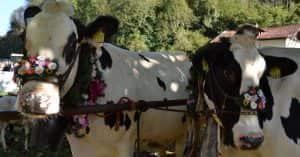
Transhumance festival
In autumn, local communities in the Trentino-Alto Adige region celebrate herds coming down from Alpine pastures. These are extremely merry events, especially popular with children.
Details
Ladin Carnival and traditional masks
The Dolomites have their own traditional carnival masks. During the festival, music, dance and colours fill the streets of Val di Fassa and Val Gardena re-enacting Ladin culture.
Details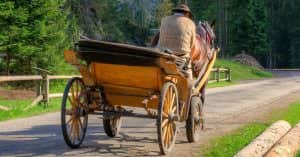
Horse-pulled sleigh tours
Horse pulled sleight tours can be romantic or fun-filled according to the company! In winter take in the snow-clad scenery. In summer breathe in the scent of grass at a slow pace.
Details
Meeting the deer
Seeing deer and roe deer in their natural habitat is a true privilege. Make it happen in the Paneveggio Natural Park.
Details
Unika sculpture fair in Val Gardena
The fine art of woodcarving is in Val Gardena's DNA and gets celebrated every year during the UNIKA fair. See artworks come to life in the hands of skilful carvers and choose one to bring home.
Details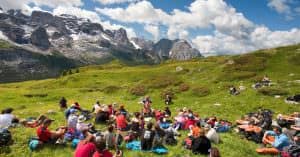
I Suoni delle Dolomiti
Famed artists perform their music in July and August. Shows take place in natural theatres of high-altitude meadows and clearings in the woods.
Details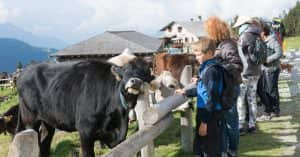
Sunrise at mountain huts
Sunrise at mountain huts is a memorable experience: after helping milk the cows, you can try your hand at making yogurt, cheese and butter.
Details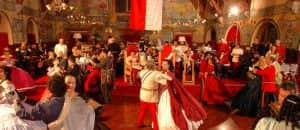
Habsburg Carnival
The Habsburg Carnival in Madonna di Campiglio is the ultimate carnival experience in the Dolomites. You'll feel like you're living at court, surrounded by princes and princesses.
Details